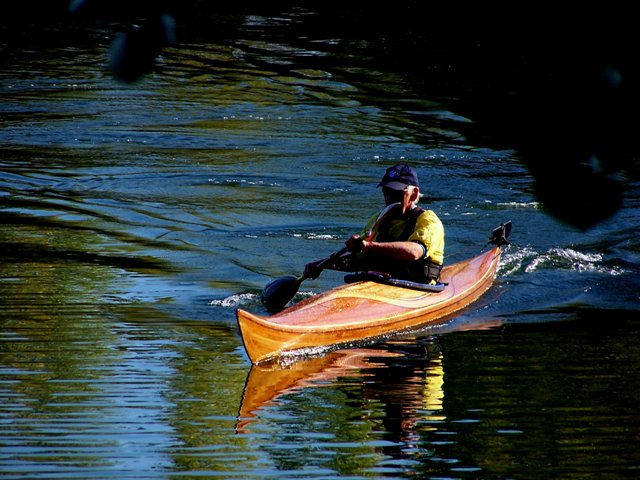

This is the Cape Ann Storm finished in September 2009.

High Performance Cruiser with bulkheads and water-tight deck hatches.
Length: 17.5 feet, Width, 22 inches, Weight: 50 lbs.
(click pictures below to enlarge)
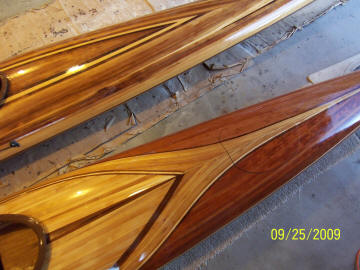
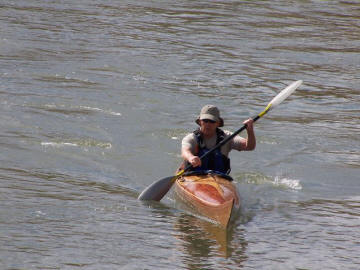
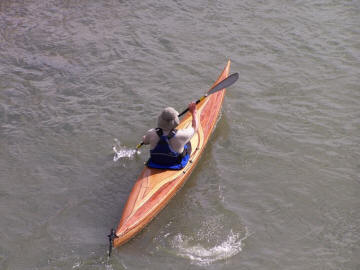
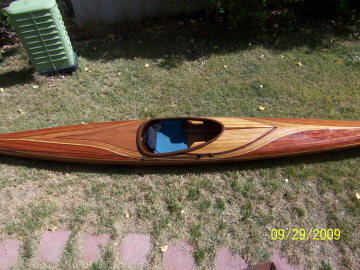
Below is the Cape Ann Expedition finished in 2007
Type: Expedition Cruiser
Length: 18.5 feet, Width 22 in., Weight: 55 lbs.
Cape Ann Storm and Cape Ann Expedition both started from plain old boards from my local lumber yard. To convert the raw lumber into kayaks I used the instruction manual written by Vaclav Stejeskal http://oneoceankayaks.com/ His manual is excellent and easy to follow. His kayak designs are superb. His kayak designs comparison page http://oneoceankayaks.com/kayakpro/kayakgrid.htm impresses me and shows he really knows what he's doing.
My contact info: [email protected]
June 9, 2007: Paddled Cape Ann Expedition 15 GPS miles down the Colorado River (Redlands to Loma) in 1 hour 30 min with average speed of 9.1 MPH (max speed 12.4) with streamflow 8,270 cfs.
June 16, 2007: Paddled Cape Ann Expedition 25.26 GPS miles down the Colorado River (Loma to Westwater through Ruby and Horsethief Canyons) in 2 hours 47 min with average speed of 9.1 MPH (max speed 12.4) with streamflow 10,200 cfs.
NOTE: Sea kayaks make great river kayaks. Four or five foot river rapid waves and hay stacks were fun. Never came close to having a wave hit me in the chest. Speed relative to waves about 10 MPH GPS. How to paddle this boat through strong whirlpools at Black Rocks section, not sure, so paddled slowly, but forward speed, due to the current, still around 8 MPH. Long bow of this boat sticks pretty hard in swirls and eddies of pushy water, but is more forgiving than my wildwater racing kayak.
2008-2009: I paddled Expedition in races on Lake Superior (Twin Harbors, MN), Lake Michigan (Chicago Shoreline Marathon), and Lake Dillon Challenge (elev. 9,100 feet) in Colorado. The Expedition performed well and place 1st or 2nd each in each race. The designer's data indicates that the Cape Ann Storm should be slightly faster at race pace, so in 2010 I'll use the Storm for racing.
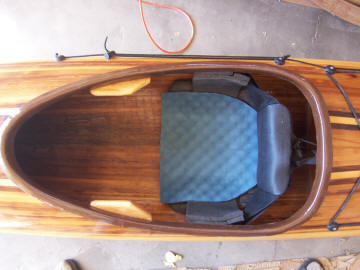
Below is an experimental boat
Since racing sprint kayaks in the 1970's I've always wondered how a 21 foot long K-2 sprint kayak would work as solo expedition kayak. My fiberglass K-2 hadn't been paddled in many years and it didn't have any prospects for future K-2 use so I decided to use it for experimenting. I turned it into a solo long distance kayak. Before doing that I tried it with a high seat and outriggers, I paddled it single blade and double blade. At one point I put a sliding seat in it and paddle single blade and was able to drive with my legs just like a rowing shell. After all that fun, I added the wood deck shown in the picture below. On the plus side, it has enough bouyancy for two men, but on the negative side it has a low level deck design that is bad rough water and below deck gear storage. I could probably strap a big dry bag to the flat deck as I've done on other kayaks (see picture below), but probably will never have to do that now that I have an X-Par Missle (see other picture below). The boat in it's final form is about the same speed as my wildwater kayak.
In the end I got a good deal on a used and modified X-Par Missile that had bulk heads, water tight hatches, and a flip up rudder already installed. This is now my expedition and unlimited class race boat. It is 23 feet long, 18 inches wide, and weighs 35 pounds and is faster than my wildwater K-1 and faster than my 30 year old sprint K-1. It is sea worthy and is stable in large river waves. Most of all it is an excellent boat for paddling up a river because of its speed, particularly in shallow water which is plentiful when hugging the bank. Here is a picture of it.
For multi-day trips on rivers not suitable for sea kayaks, here's how to carry gear on a whitewater kayak i.e., just strap it to the deck.
Below is cedar strip raft built in 1994 for racing in the Delta Crazy Raft Race
This was my first cedar strip boat. The construction was crude, minimal, and as cheap as possible including cheap polyester resin. We didn't even fiberglass the inside of the hull. At the start of the race we took off so fast that we left Marci on the bank so we had to go back to get her. In the chaos we got hit by another raft (not Marci's fault) and we started taking on water. Our raft's unsinkable design was modeled after the Titantic with multiple bulkheads. One chamber flooded while the others remained dry until the water flowed over the top of the bulkhead and into the next chamber and so on. Fortunately, we thought enough to fill our raft with experienced canoe racers (ringers?) who propelled us to the finish line before we sank and ahead of all the other rafts except one. Great fun!
The Crew: Cap Allen, Dan Carroll, John Kent, Jerry Nolan, Marci Nolan, John Walker